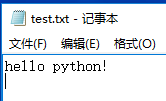python sys.argv[]用法
阿新 • • 發佈:2018-12-31
sys.argv[]是用來獲取命令列引數的,sys.argv[0]表示程式碼本身檔案路徑,所以引數從1開始,以下兩個例子說明:
1、使用sys.argv[]的一簡單例項:以下是sample1.py檔案:
- import sys,os
- print sys.argv
- os.system(sys.argv[1])
2、這個例子是簡明python教程上的,明白它之後你就明白sys.argv[]了。
以下是sample.py檔案:
-
#!/usr/bin/env python
- #_*_ coding:utf-8 _*_
- import sys
- def readfile(filename): #定義readfile函式,從檔案中讀出檔案內容
- '''''''''Print a file to the standard output.'''
- f = file(filename)
- whileTrue:
- line = f.readline()
- if len(line) == 0:
- break
-
print line, # notice comma 分別輸出每行內容
- f.close()
- # Script starts from here
- print sys.argv
- if len(sys.argv) < 2:
- print'No action specified.'
- sys.exit()
- if sys.argv[1].startswith('--'):
- option = sys.argv[1][2:]
-
# fetch sys.argv[1] but without the first two characters
- if option == 'version': #當命令列引數為-- version,顯示版本號
- print'Version 1.2'
- elif option == 'help': #當命令列引數為--help時,顯示相關幫助內容
- print'''
- This program prints files to the standard output.
- Any number of files can be specified.
- Options include:
- --version : Prints the version number
- --help : Display this help'''
- else:
- print'Unknown option.'
- sys.exit()
- else:
- for filename in sys.argv[1:]: #當引數為檔名時,傳入readfile,讀出其內容
- readfile(filename)
在與sample.py同一目錄下,新建3個記事本檔案test.txt,test1.txt,test2.txt,內容如下圖:


C:\Users\91135\Desktop>python sample.py
['sample.py']
No action specified.
C:\Users\91135\Desktop>python sample.py --help['sample.py', '--help']
This program prints files to the standard output.Any number of files can be specified.
Options include:
--version : Prints the version number
--help : Display this help
C:\Users\91135\Desktop>python sample.py --version['sample.py', '--version']
Version 1.2
C:\Users\91135\Desktop>python sample.py --ok['sample.py', '--ok']
Unknown option.
C:\Users\91135\Desktop>python sample.py test.txt['sample.py', 'test.txt']
C:\Users\91135\Desktop>python sample.py test.txt test1.txt test2.txt
['sample.py', 'test.txt', 'test1.txt', 'test2.txt']
hello python!
hello world!
hello wahaha!
goodbye!

